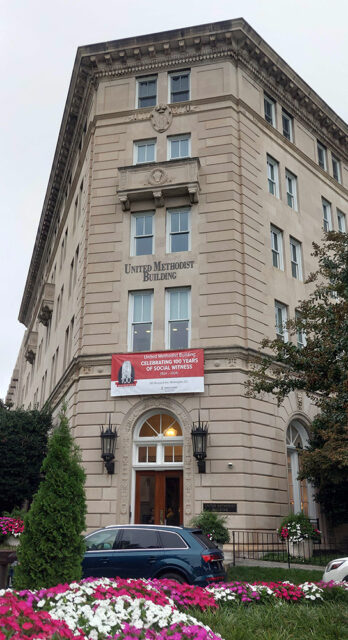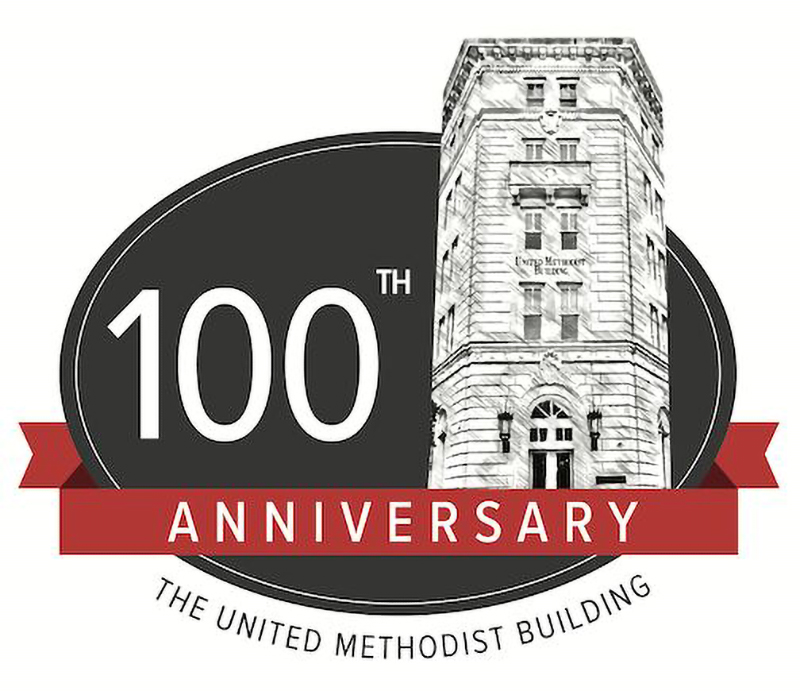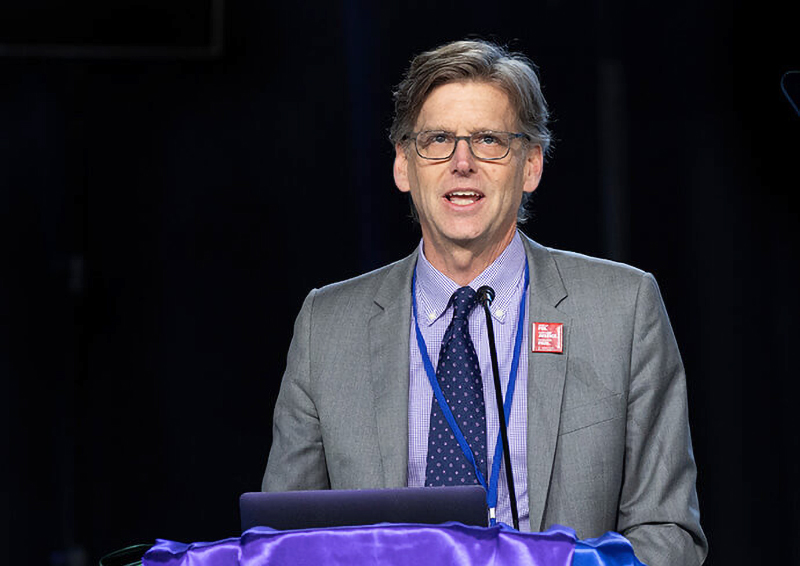The building has been “instrumental” in movements for “peace and justice, a gathering spot for strategizing, for building consensus, and then for going across the street to either do public witness or do direct advocacy with decision makers,” Hill said. It hosted a demonstration in support of the 2018 March for Our Lives protest for gun control legislation, for instance, and was recently the site of a prayer vigil calling for a cease-fire in Gaza and organized by Churches for Middle East Peace.
Hill remembers too when staff huddled in the building and observed the Jan. 6, 2021, attack on the U.S. Capitol.
John Hill, then-interim general secretary of the Board of Church and Society, addresses the 2024 United Methodist General Conference in Charlotte, N.C. (Photo by Mike DuBose, UM News)
“We had to make decisions about who needed to stay and and who needed to be sure to evacuate the premises,” Hill said, noting that the Methodist Building’s unusual location means its staff are often in “constant conversation” with U.S. Capitol Police and other law enforcement agencies, such as the U.S. Secret Service.
The building also provided a unique service on Sept. 11, 2001, when it remained open for prayer despite evacuations of nearby federal buildings amid fears the Capitol could be attacked. Capitol police officers were invited inside to contact loved ones.
Hill recalled when faith leaders held daily vigils in front of the building to advocate for a federal budget that “reflects the values and priorities of our society,” and when the building hosted a 24-hour vigil in support of the Affordable Care Act in 2017 amid a Republican-led effort to repeal the health care law.
“(A) former colleague and others on our staff were at the 3 a.m. shift, out there with flashlights,” he said. “Holding that vigil for 24 hours was pretty powerful.”

The 100th anniversary of the United Methodist Building is being celebrated in Washington, D.C. (RNS photo/Adelle M. Banks)
The building has also literally provided the backdrop to various major protests, such as when demonstrators flocked to the Supreme Court after justices overturned Roe v. Wade. The building had changed its sign after a draft of the decision leaked a month earlier, adding a message that read “Christ Values and Trusts Women. Follow Christ.”
Hill said what goes on the sign is decided by the group’s general secretary and communication staff. It has “always been an effective tool for witness and kind of public facing statements,” he said, adding that it strives to educate passersby on the “faith position” regarding various policies.
When Congress was debating potential voting rights legislation, the sign read: “Voting rights are sacred.” When tensions between the U.S. and Iran flared in May 2019, the sign read: “Diplomacy works. Support the Iran deal. No war with Iran.” And when outrage grew over the Trump administration’s family separation policy in summer of 2018, the sign’s message took on a sardonic tone, reading: “‘I was a stranger and you ripped my child from me,’ wait a second … ”
Granted, the building’s advocacy-minded mission hasn’t always sat well with all Methodists. In 2010, a group of Methodists filed suit, arguing the funds raised to construct the building and revenue earned from renters should be used only to fight alcoholism and support temperance. But a District of Columbia judge ruled against them, saying evidence presented at trial “clearly show that throughout the years, the Boards were also authorized to, and did, perform substantial work on other ‘public morals’ issues.”
For his part, Hill will be leaving the building this year, but said he departs hopeful the building will remain a place of forward-thinking advocacy for another century to come.
“I leave supremely confident that whatever the issues of the day are present, that this building, and the occupants of this building, and the folks who are connected to the work through this building, will be wrestling with those issues and working for justice,” he said.
 United Methodist Building 100th anniversary logo. (Courtesy image)
United Methodist Building 100th anniversary logo. (Courtesy image)


